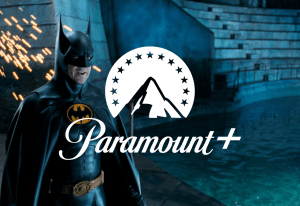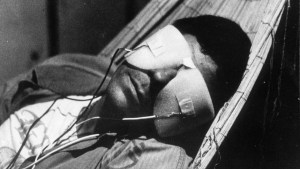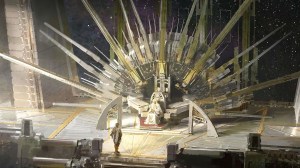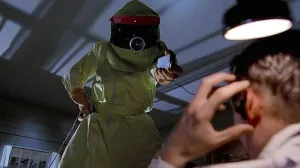The majority of the Legion series premiere was unveiled to the audience within the confines of the Clockworks Psychiatric Hospital. Having that locale as a backdrop quickly lets fans know that they are in for something a little different from the FX, X-Men adaptation.
Videos by ComicBook.com
The trippy visuals, intense moments of introspection, and appropriate climax cements that this different is also better.
If Legion found its way to your viewing screen on accident, there’s a strong chance you wouldn’t know that the show featured any connection with the vaunted mutant franchise at all. It is not just for the lack of true superhuman power on display for the majority of the premiere– which holds until the conclusion to highlight its most conventionally exciting moment — but also the night-and-day difference between Legion environments and the cityscapes most comic book TV series paint as a background of real-world crime-solving so their heroic figures (and villains) can stand separately.
In Legion, reality doesn’t really enter the equation. The world we’re in is unmistakably David’s; and it is unique enough to scatter his senses and heighten our interest.
Opposite of the traditional origin story, the opening hour lays out how overwhelming everything is for David before he finally links up with the apparently powerful mutants that plan to show him just what he’s capable of.
Somewhat removed from what look to be the main events of the series, the Clockworks hospital’s cast of characters may surprisingly be missed. David’s treatment appears distressing but with all the diversions on display it’s easy to see where refuge are available.
Ping pong table? Check.
Hide and seek? Sure.
All types of greenery covering one of the day room walls. Soothing.
Even though there’s a lot of Clockworks that has not been shown, the time spent eating Twizzlers and playing name-the-side-effect with Lenny doesn’t sound like the worst way of killing time.
When Syd Barrett appears — and Lenny helpfully enumerates some of her striking features — everything for David gets inverted.
In Legion the story is flipped around, too. David’s emotional center is projected outwards and the true mystery of the series is what goes on inside. So it’s fitting that David’s eyes seem to want to jump out of their sockets at times and that he takes an interest in Syd when her optical cues are just as openly interpretable.
The audience is coaxed to focus on the brilliant group therapy scene where David and Syd first connect. It isn’t too subtle of a hint that this scene’s hiding something and most of it is told through David’s face when he brings up the incident with Dr. Poole.
The scene’s shining gem was Syd and her compelling argument: “What if your problems aren’t in your head? What if they aren’t even problems?”
For his entire life, David Haller has been told that it’s all his fault. The problem is in you, not me. The “hall of mirrors” structure to Chapter One seems to bounce between events in an indiscriminate fashion, but on close inspection it’s actively illogical. It can be scary.
One could imagine hearing voices — or being told you are — might feel similar. There’s a vast difference between not understanding anything and knowing that nothing can be understood. If what David thinks he’s seeing truly is real, then the fabric of society could unravel—so society makes sure he thinks that it isn’t.

If Clockworks is a (mostly) tranquil replication of David’s inner experience, the mysterious interrogation we start getting glimpses of after Syd helps him broaden his horizons might better reflect how those on the outside see his condition.
The key words are “questioning everything.” Pulling yarn out of something as carefully designed as Legion is enough to send you over the edge if you’re not careful.
When David returns home to a less warm welcome than he anticipated, it probably felt all too familiar.
Waffles are tasty but they only go so far when your sister has to make up an excuse to secure the sharp objects before you crash for the night. It’s no wonder that David’s friendship with Lenny extends beyond death when even his family can be so so distant.
When David dreams he’s returned to Clockworks, it illustrates his internal confusion. David and Syd dance in Bollywood fashion, but to music by a South African with lyrics sung by a Frenchman referencing a novel by a Russian. And whoever was supposed to keep Lenny out of the room with all the drugs is in big trouble.
David’s escape from Division 3 at the episode’s end makes about as much sense as the dream that it interrupted, and he knows it. But it’s not as if reality is any more forgiving. Whatever phase David’s in, the tide carries on and so does he.
That still leaves so much to digest in the epic opening hour.
- The day room incident. It’s easy to see why the details baffle the interrogators. Whatever happens in the day room that causes everything (ping pong ball excluded) to disappear and apparently kills Lenny is a mystery to the audience. Lenny says Syd did it when she “was” David, but that’s all we really know.
- The main thing that is shown is that the in-show chronology of the incident, the interrogation, and the end of the episode doesn’t seem to fit linearly. It also appears that David sees flashes of the day room years earlier, after the argument with Philly while all their kitchen belongings whirl around him.
- The incident in the day room is filled with references that seem to point at this mixed-up lineage, such as the revolving line of dancers on television screens, the ping pong match, or Lenny doing aimless figure-eights in a wheelchair. Even the setting could be giving us a hint on where to look — The Day Room is a play by American giant Don DeLillo that doesn’t reveal its chronology until the final moments.
- The last peaceful glimpses we get of Clockworks are the great montage of David and Syd’s first days as a couple sound tracked by The Rolling Stones’ “She’s a Rainbow” and their imagined kiss by the hospital’s high windows. It’s a clever and efficient way of showing us the kinds of personalities David encounters.
- David and Syd’s conversation about cherries, crust, and orange-flavored things is charming. Schizophrenic-labeled taste buds seem to have very strong preferences. A given taste can prompt a familiar way of thinking—or a bad memory.
- The levitation we witnessed as part of FX’s Super Bowl push isn’t a careless superhero reference. When the character’s psychiatric hospital lodgings are introduced in New Mutants #26 (written by Chris Claremont with art by Bill Sienkiewicz), levitation features prominently.
- David also briefly levitates in his bed at Clockworks, while evidently dreaming of a mysterious “devil with yellow eyes”. The character’s identity has prompted a lot of chatter in our back rooms (and on some other sites too). What’s funny is that we’ve already heard three X-Men characters that people are “certain” it’s referencing. Let us know your ideas on Facebook or Twitter.
- The series doesn’t appear to take place in our reality, but there are a lot of seeming references that could only be made by someone living in tune with the real world. The Calvino Fire Department outside of Clockworks is a sure reference to Cuban-born Italian author Italo Calvino, whose work often plays with perspective or chronology. The apparent boss of David’s interrogation who watches it from the monitor room is named Captain Brubaker, and he mentions an incident at “Red Hook”. The latter seems to be a possible nod to H.P. Lovecraft’s The Horror at Red Hook.
- That said, the medication David says he’s taking is Haldol, which was approved by the real-world FDA as an anti-psychotic treatment in 1967.
Coming out of the premiere with so many answers but even more intriguing questions is likely to make this show a must-watch for fans of the mutant franchise. There are plenty of lanes to explore and the back story of Legion is one that can help fix many of the continuity problems that has plagued this particular franchise for year.
— Zach Ellin reviewed the first three episodes of Legion, and will provide coverage throughout the entire season of the show for ComicBook.com. Follow him on Twitter for more of his insights.
MORE ON LEGION:
Five X-Men Comics To Read Before Watching Legion
Which X-Men Does Dan Stevens Want On The Show?
All Marvel Shows Currently In Production









